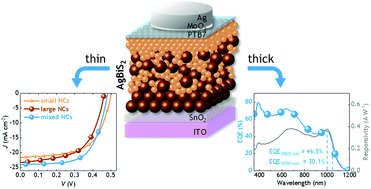Mixed AgBiS2 nanocrystals for photovoltaics and photodetectors†
Abstract
Heavy-metal-free colloidal nanocrystals are gaining due attention as low-cost, semiconducting materials for solution-processed optoelectronic applications. One common limitation of such materials is their limited carrier transport and trap-assisted recombination, which impede the performance of thick photoactive layers. Here we mix small-size and large-size AgBiS2 nanocrystals to judiciously favour the band alignment in photovoltaic and photodetector devices. The absorbing layer of these devices is fabricated in a gradient fashion in order to maximise charge transfer and transport. We implement this strategy to fabricate mixed AgBiS2 thin film solar cells with a power conversion of 7.3%, which significantly surpasses the performance of previously reported devices based on single-batch AgBiS2 nanocrystals. Additionally, this approach allows us to fabricate devices using thicker photoactive layers that show lower dark currents and external quantum efficiencies exceeding 40% over a broad bandwidth – covering the visible and near infrared range beyond 1 μm, thus unleashing the potential of colloidal AgBiS2 nanocrystals in photodetector applications.



 Please wait while we load your content...
Please wait while we load your content...